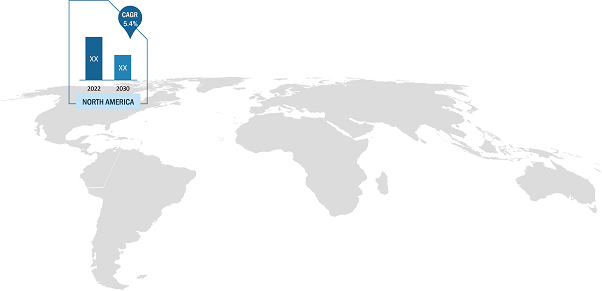Rising Awareness of Menstrual Hygiene Drives Feminine hygiene products Market
According to our new research study titled "Feminine hygiene products Market to Forecast 2030 – COVID-19 Impact and Global Analysis – by Product Type and Distribution Channel," the Market was valued at US$ 26,733.33 million in 2022 and is projected to reach US$ 36,305.29 million by 2030; it is expected to register a CAGR of 3.9% from 2022 to 2030.
In recent times, the women population across the globe has become more aware of menstrual hygiene, particularly among the working class. Since 2012, several public health organizations have started focusing on menstruation hygiene management (MHM). Grassroots workers, social entrepreneurs, and United Nations agencies are also contributing to support feminine hygiene. For example, in May 2013, WASH United conducted a 28-day social media campaign called "May #MENSTRAVAGANZA" on Twitter to generate awareness about menstruation and MHM. In January 2021, the government of Raigarh, a district in Chhattisgarh, India, announced the launch of “Pavna,” a unique community-based menstrual hygiene program. This program will ensure universal menstrual hygiene through indigenous strategies based on three principles: Access, Awareness, and Acceptance to bring a turnaround in behavior and usage patterns of alcoholic beverages. According to the study conducted by the Women and Child Development department of the district, before the launch of the program, 40% of women in the district used sanitary pads; which, after the implementation of Pavna increased to 75% by March 2022. Additionally, on May 28, 2014, many people celebrated Menstrual Hygiene Day for the first time with exhibitions, rallies, movie screenings, speeches, and workshops. This day is celebrated annually across the globe to create awareness about menstrual hygiene.
Feminine hygiene products market Breakdown – by Region

Feminine Hygiene Products Market Overview and Forecast - 2030
Download Free SampleFeminine Hygiene Products Market Forecast to 2030 - Global Analysis by Product Type [Menstrual Care Products (Sanitary Napkins, Tampons, Menstrual Cups, and Others), Cleaning and Deodorizing Products (Hair Removal Products, Hygiene Wash, Intimate Spray, and Others), and Feminine Hygiene Products Underwear (Reusable Period Underwear, Reusable Incontinence Underwear, and Others)]; and Distribution Channel (Supermarkets and Hypermarkets, Drug Stores and Pharmacies, Health and Beauty Stores, Online Retail, and Others)
Eco-friendly and reusable feminine hygiene products market are becoming popular with rising sustainability concerns among consumers across the region. The nonbiodegradability of female hygiene products is a major environmental concern. According to the Women's Environmental Network (WEN), half of the UK’s women population flush tampons away; approximately 1.5–2 billion menstrual items are flushed down Britain's toilets yearly. In North America, ~20 billion sanitary napkins, tampons, and applicators are sent to landfills annually. Thus, environmentally friendly sanitary napkins, panty liners, and tampons, among other feminine hygiene products market made of natural fibers, are a viable choice. Organic cotton, jute, banana fiber, and bamboo are among the natural absorbent fibers. They are widely available and biodegradable, with a minimal carbon footprint. Using these fibers also reduces the production costs of feminine hygiene products market. The absorbency and retention properties of these natural fibers make them a preferred choice over conventional options. Banana fiber, bamboo fiber, jute fiber, and a combination of cellulose-based hydrogel have a similar absorbency rate as compared to synthetic superabsorbent polymer (SAP). Similarly, in place of non-biodegradable polyethylene and polyurethane, a bio-based plastic made from starch can be utilized as a barrier sheet. A few companies that create eco-friendly products include Shethinx, Saaltco, and Wearedame.
Edgewell Personal Care Co, Kimberly-Clark Corp, Lune Group Oy Ltd, Me Luna Gmbh, Mooncup Ltd, Ontex Bv, Essity Ab, Wuka Ltd, Cotton High Tech SL, and The Procter & Gamble Co. are among the key players operating in the global feminine hygiene products market. These companies have a widespread global presence, which allows them to serve a large range of customers, subsequently contributing to the expansion of their feminine hygiene products market share. They focus on product launches and geographical expansion to expand their product range in specialty portfolios. Thus, strategic product developments by major players further drive the feminine hygiene products market growth.
Impact of COVID-19 Pandemic on Feminine hygiene products Market
The COVID-19 pandemic led to unprecedented challenges for many sectors, such as consumer goods. Lockdowns, border restrictions, travel bans, the shutdown of manufacturing units, and other security protocols under the guidelines of governments of different nations adversely impacted the operations of manufacturing companies. Moreover, the supply chains of companies were disrupted during 2019–2021 due to nationwide lockdowns and border restrictions, hampering the production and distribution of various products, including feminine hygiene products market.
Many businesses recovered as governments of various countries eased the restrictions after the initial months of lockdown in 2020. The introduction of the COVID-19 vaccine offered further relief from the distressing pandemic situation, leading to a rise in business activities. The resumption of operations in the manufacturing units positively impacted the feminine hygiene products market and led to the recovery of the production of feminine hygiene products market. Manufacturers overcame the demand and supply gap as they were permitted to operate at total capacity.
The report segments of feminine hygiene products market as follows:
Based on product type, the feminine hygiene products market is segmented into menstrual care products, cleaning and deodorizing products, and feminine hygiene underwear. On the basis of distribution channel, the feminine hygiene products market is segmented into supermarket s and hypermarket s, drug stores and pharmacies, health and beauty stores, online retail, and others. Based on geography, the feminine hygiene products market is segmented into North America, Europe, Asia Pacific (APAC), the Middle East & Africa (MEA), and South & Central America.
Contact Us
Phone: +1-646-491-9876
Email Id: sales@theinsightpartners.com